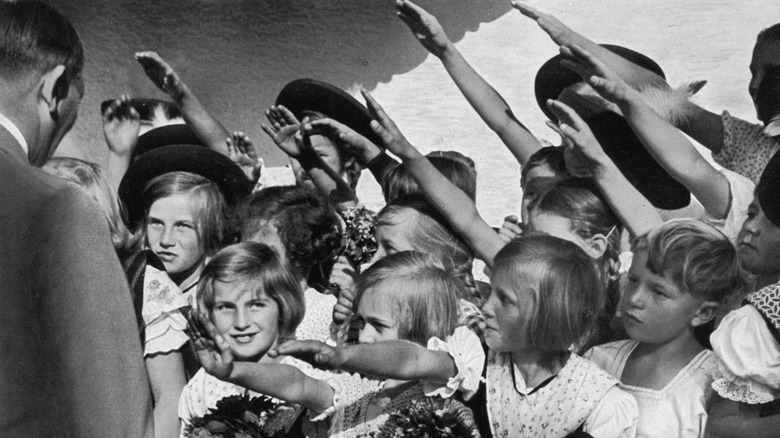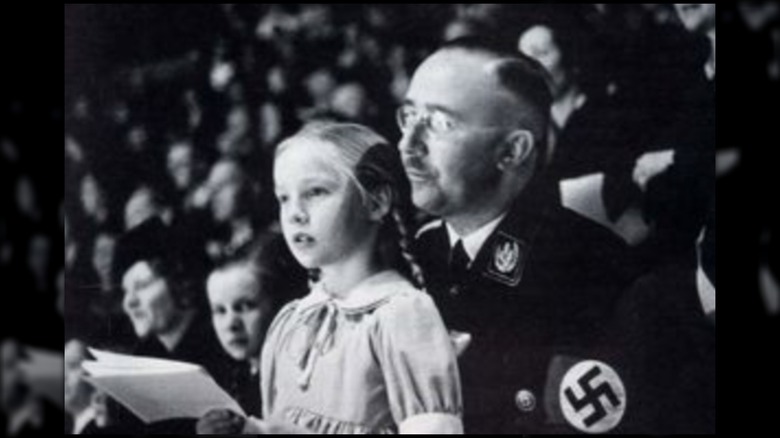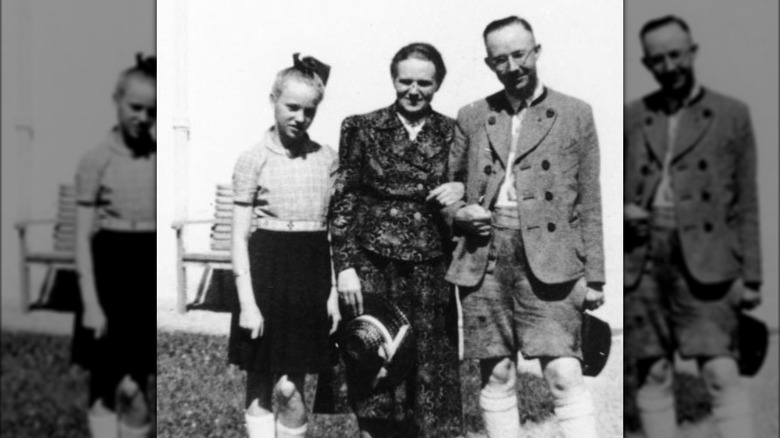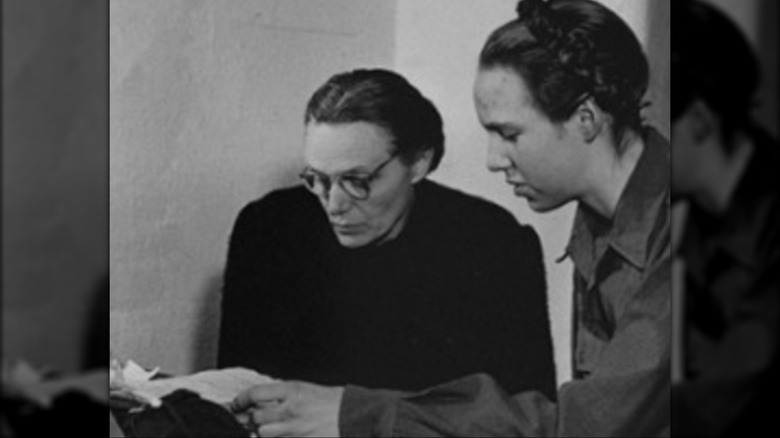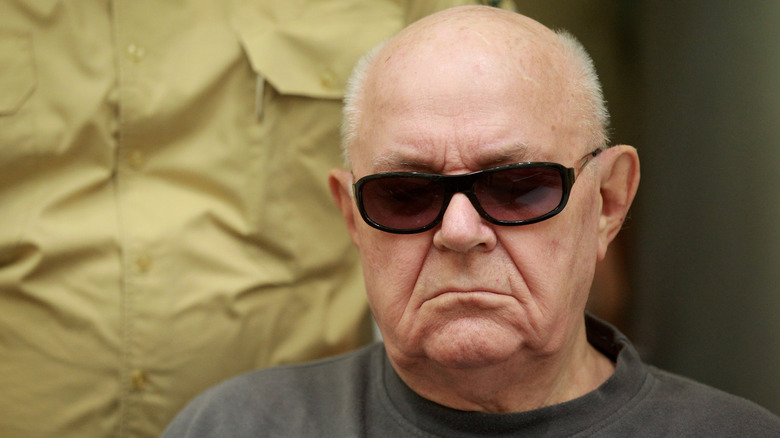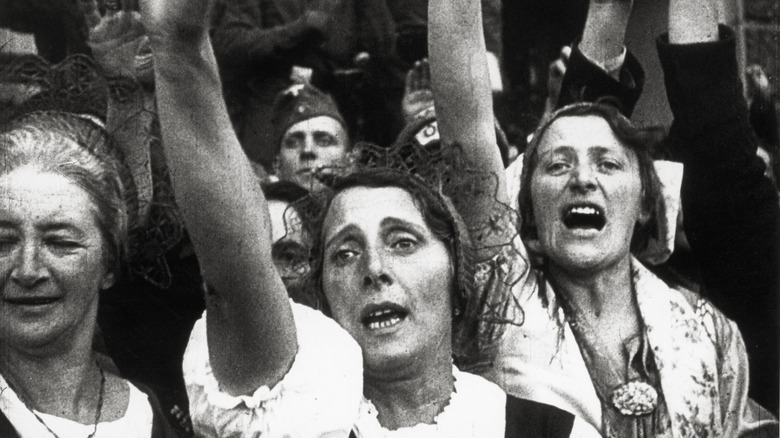Who Was The 'Nazi Princess' Who Worked In German Foreign Intelligence Under A Fake Name?
One word you don't normally see used in conjunction with Nazi is princess, but Gudrun Himmler managed to earn this nickname because of her connection to Hitler's regime. Gudrun Himmler was the daughter of Heinrich Himmler, who is considered the "chief architect of the Holocaust," according to the BBC. Himmler hoped to succeed Adolf Hitler and was actively negotiating a surrender to Western Allies, per Britannica. Hitler had Himmler arrested in May 1945, according to The Washington Post, after he became aware of these plans. Himmler attempted to escape, and when that plan didn't work, he poisoned himself by swallowing a cyanide capsule shortly after he was captured, according to a 1945 article from the UPI archives.
Gudrun was 15 years old when her father died. With the Nazi regime coming to an end in April 1945, she and her mother made their way to Italy, where they were captured by American soldiers the same month Heinrich Himmler was arrested and died, per The New York Times. After they were released, she moved back to Munch in 1952 (via Daily Mail). Despite being judged for it, Gudrun used the last name Himmler until she married Dieter Burwitz in the late 1960s, who worked with the National Democratic Party of Germany, per the Independent.
Gudrun Burwitz adored her father
Like many daughters, Gudrun cherished her father, and she never stopped trying to restore his name. In fact, Tania Crasnianski, author of "The Children of Nazis" writes that Gudrun was "sure her father had done nothing wrong," adding that she wanted to write a book about his great character, but never got around to it (via The New York Times).
Gudrun became somewhat obsessed with her dad, and she collected photos of him in a scrapbook. She also reportedly said that her father was a great man, who was misunderstood, and that his reputation had been "destroyed by the Jews," according to Daily Mail. She also refused to believe that her father killed himself, and claimed the British murdered him. "I don't believe he swallowed that poison capsule," she said. "My mother and I never had official notification of his death. To me, the photo of him dead is a retouched photo of when he was alive," reports the Mirror.
She visited a concentration camp and even met Hitler
Gudrun visited concentration camps with her father. In 1941, he took her to Dachau, where more than 30,000 Jews were killed. "We saw everything we could," the young girl wrote in her diary. "We saw the gardening work. We saw the pear trees. We saw all the pictures painted by the prisoners. Marvelous. And afterward, we had a lot to eat. It was very nice," The New York Times reports. Strangely enough, the family lived only 15 miles from the camp (via the Mirror).
She even met Hitler on a few occasions. "On December 24 each year I used to drive with my father to see Hitler at the Brown House in Munich and wish him Merry Christimas (sic)," she reportedly wrote in her diary. She even explained that when she was young, Hitler would give her dolls. As she got older, he gave her boxes of chocolates, according to the Mirror.
Gudrun worked for Germany's foreign intelligence under a fake name
Gudrun worked for West Germany's Federal Intelligence Service spy agency, Bundesnachrichtendienst (also known as the BND) as a secretary from 1961 to 1963 under an assumed name, per The New York Times. This information didn't come to light until after Gudrun died in 2018. However, it is unclear whether she actually worked as a secretary, or she spied for the BND, or was spying on the BND, per Daily Mail. Her departure occurred after a change in how employees associated with the Nazis were handled, according to Reuters.
The Associated Press (AP) reports that documents show that the agency knew who she was and even helped her secure an interview with a German newspaper for payment. Gudrun reportedly worked at the agency under Reinhard Gehlen, a German World War II general who also worked with United States intelligence after the war. He reportedly employed many officers and former Nazis as spies (via the AP).
She helped Nazis after the war
Gudrun also belonged to an organization that helped Nazi War criminals, per The New York Times. The group, called Stille Hilfe (meaning "Silent Help" in English), aided many Nazi members with hiding places and ways to leave Europe (via War History). Some of the men she reportedly helped after the war include Sumeal Kunz, who is linked to the murders of more than 400,000 people. She also helped Anton Malloth, who escaped justice for 50 years after beating 100 prisoners to death. Another Nazi criminal she aided was John Demjanjuk, (pictured) who had a hand in killing over 27,000 prisoners and was known for enacting violence on prisoners, per War History Online.
It is even reported that the group was still helping Nazis as recently as 2015, (via the Mirror). When approached near her home in 2015, Gudrun said that she never talks about her work, adding "I just do what I can when I can," reports the Mirror.
Gudrun was a 'Nazi princess' and a 'true believer'
Oddly enough, some admired Gudrun for what she did. Oliver Schrom, co-author of the book "Silent Help for Brown Comrades," explained that she was a "dazzling Nazi princess, a deity among these believers in the old times," adding that while she wasn't in a leadership position, she was popular and keen on having former SS men come to her and tell her their names," per The New York Times.
Unlike other children of Nazi criminals, Gudrun never tried to distance herself from her father's crimes. "She has a genuine love for these men and women who served the worst parts of the Nazi regime from 1933 until 1945. She is a true believer and, like all zealots, that makes her dangerous," an official told the Mirror. And she apparently remained that way before she died, attending neo-Nazi rallies until her last days.
